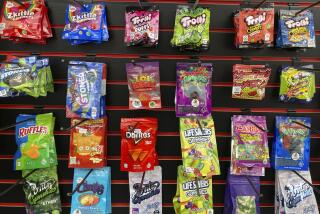Younger Teens’ Drug Use Leveling Off, Study Finds
- Share via
WASHINGTON — Illegal drug use among younger teenagers appears to be leveling off after rising throughout the 1990s, and fewer young teens are choosing to start smoking, according to a major study released Saturday.
For older teens the picture is mixed. Marijuana use is still ticking upward, but the use of other illicit drugs is growing little or not at all, according to the survey.
Although the leveling-off may turn out to be a turning point, teen drug use remains sharply higher than it was at the beginning of the decade.
Since 1991, illicit drug use has nearly doubled among eighth-graders, according to the survey, with 22% telling researchers in 1997 that they had taken an illicit drug sometime in the last year.
Comparable figures were 38.5% for 10th-graders and 42.4% for 12th-graders. The latter two figures both represent increases over 1996, but for 10th-graders the rate of increase was the lowest since 1993.
Similarly, daily cigarette use among 12th-graders is at its highest level since 1979.
The study’s authors say that while the plateau in drug use among younger teenagers is good news, they would like to see another year of data in several areas to ensure that it is not an aberration.
“This is mathematical good news but does not in any way state that we have seen victory over this drug problem. These are marginal changes in attitudes, in drug-use rates among American youngsters,” said Gen. Barry R. McCaffrey, director of the Office of National Drug Control Policy.
At the same time, he said he was encouraged “that the slope of the curve has changed, and after five years of inexorable increase in drug use by youngsters in all of these age groups, it either stabilized or went down.”
*
President Clinton used the release of the survey as an opportunity in his weekly Saturday radio address to encourage parents to talk with their children about the dangers of illegal drugs and to highlight a $195-million federally financed advertising campaign to discourage children from using illegal drugs.
“Our goal is to make sure that every time a child turns on the television or surfs the Internet, he or she will get the powerful message that drugs can destroy your life,” Clinton said.
Parents are the first line of defense in the drug war, Clinton emphasized. “The most effective strategy we have against drugs begins at home. . . . It’s a fight that can be won at kitchen tables across America.”
The survey, which was conducted by the University of Michigan’s Institute for Social Research with a grant from the government’s National Institute on Drug Abuse, involved 51,000 teenagers at more than 400 public and private secondary schools nationwide. The survey has been conducted for 23 years and is regarded as a significant barometer of drug use trends among young people.
Marijuana use, which is considered by many researchers as a warning sign that a teenager may be at risk of using other drugs, leveled off among eighth-graders in 1997 and increased only a statistically insignificant amount among 10th-graders. Marijuana use by 12th-graders continued to rise but at a slower rate than in the early 1990s.
Lloyd Johnston, the study’s chief investigator, said the trend in marijuana use squared with a change in attitudes toward marijuana.
“During the early 1990s, we saw a considerable decline in the proportions of students reporting marijuana use as dangerous,” Johnston said. Now the proportion of younger teenagers that say they disapprove of even occasional marijuana use is edging up.
“We know there is a relationship between whether you think a drug is dangerous and whether you use that drug,” said Health and Human Services Secretary Donna Shalala. “What’s happening is that eighth-graders are beginning to get very clear messages, first from their parents, then from their teachers and from the rest of us, that these drugs are dangerous.”
The use of hallucinogens, such as LSD, remains low compared to that of marijuana, but it too appears to be reaching a plateau.
In contrast, cocaine use continued to rise among 10th-graders and 12th-graders. Among eighth-graders it declined slightly.
Cigarette smoking continued to rise among older teens despite increasing publicity about smoking’s dangers. Among 12th-graders, 25% said they had smoked daily in the last 30 days--the highest proportion since 1979.
*
“Cigarette smoking constitutes the single largest threat to the health and longevity of this generation of young Americans,” Johnston said, “which makes the substantial increase in their smoking rates over the past five or six years of particular concern.”
Though younger teens appear to be beginning to understand the dangers of smoking, they are still starting at alarming rates, according to Johnston. From 1992 to 1996, the proportion of eighth-graders who reported smoking daily increased from 7% in 1992 to 10.4% in 1996. This year, the percentage dropped to 9%.
(BEGIN TEXT OF INFOBOX / INFOGRAPHIC)
Survey: Teen Drug Use
(Percentage of respondents in each group reporting having used any illegal drug in the last 12 months)
*--*
Grade 1991 1992 1993 1994 1995 1996 1997 8th-graders 11.4 12.9 15.1 18.5 21.4 23.6 22.1 10th-graders 21.4 20.4 24.7 30.0 33.0 37.5 38.5 12th-graders 29.4 27.1 31.0 35.8 39.0 40.2 42.4
*--*
Source: University of Michigan Institute for Social Research
More to Read
Sign up for Essential California
The most important California stories and recommendations in your inbox every morning.
You may occasionally receive promotional content from the Los Angeles Times.













